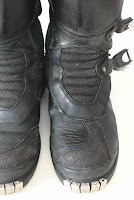As per the previous post: Michelin Anakee 2 review, my faithful Anakee's have reached the end of their life. In general I was happy with their performance so the first question is "Why change?".
However they were mounted in March 2011, I think that maybe wheel technology has evolved since then especially for the growing segment of heavy travel enduros. Also with much more players here vs. when I bought my F800GS (i.e. the new Triumph Tiger, remodelled KTM adventure 990, new Yamaha Tenere, Ducati Multiestrada) there should be some investment from tire manufacturers for the segment.
When choosing a tire, I first filter by major brand names (Michelin, Bridgestone, Dunlop, Metzeler, etc..), the reason being that the tires are the only point of contact in between the machine and the ground. You can have all the electronics in the world - ABS / traction control / stability programs, but if you buy a Chinese tire with less traction you will lengthen your braking distance, curving ability, etc...
Within the main brands there are various types of tire - some more for off-road use, some mixed usage and some for on-road. Here there's s difference in between the rational choice and the "What I would like to do" choice. Meaning that in my mind I would be doing enduro all day long up and down the Swiss mountains - i can see myself with a GoPro strapped to the bike in the middle of the forest with amazing Slow motion shots of drifts, dirt flying everywhere... The reality is, this never happens! I mean never! 2 years with the Anakee 2 and I probably went 8 times off-road and 900 times on-road and even then sloooowwwly. Don't want to crap up my daily commuting bike! But in spirit, I want the tire that goes everywhere just in case...
For the BMW F800GS the measurements are:
Front 90/90 21 V
Rear 150/70 17 V
The tires I found available in the market with respectable brand and F800GS size are
Recommended by BMW with Road Bias:
- Michelin Anakee 2 (mounted by BMW out of factory)
- Bridgestone Battlewing 501 (used to be mounted by BMW out of factory)
Recommended by BMW with Off-Road Bias:
- Metzler Karoo
- Continental Twinduro TKC80
Not recommended by BMW with Road Bias:
- Continental Trail Attack
- Pirelli Scorpion MT90
- Metzeler Tourance
- Michelin Anakee 3 (probably too new to be recommended by BMW)
Some of these are tubeless tires, but to use with BMW F800GS stock rims you need a tube.
So emotionally why not get the pure enduro tires for a what if situation? But good for me the rational part kicked in... I need road grip!
I already had tried the Battlewings and not liked them and I have a bad impression of Pirelli tires in general, which left me with the Anakee 2, Metzeler Tourance or Anakee 3.
I chose the Anakee 3 simply because (i) it is the most Road tire of the 3, i didn't use the 20% off-road of the Anakee 2 (ii) it's cheaper than the Metzeler (iii) it has a radically different design! Why not try something new?
More to come....





.JPG)

.JPG)






